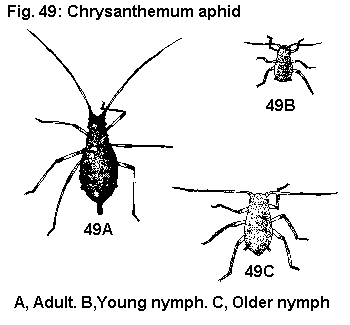DESCRIPTION Adult- The winged adults are about 2 to 2.5 mm long; soft bodied; and dark, shining mahogany brown. Due to their dark color they were once called "blackflies." Wingless adults are only 1.5 mm long. Small, black, sturdy cornicles are found on the end of the body. Nymph- Nymphs resemble smaller versions of the adult aphids (0.6 to 1 mm). Nymphs have a dull, brick-red bodies with relatively long legs and antennae. The cornicles are short and dark. The outer two-thirds of the legs and antennae are gray (young nymphs) to dark gray. Older nymphs have proportionally longer cornicles. Those destined to be winged adults have wing buds in the later instars.
Fig. 49: Chrysanthemum Aphid, Macrosiphoniella
sanborni (Gillette), Aphididae, HOMOPTERA A, Adult.
BIOLOGY Distribution- The chrysanthemum aphid is of east Asian origin, but is now found where chrysanthemums are grown outdoors as well as in greenhouses. Host Plants- Chrysanthemum is the only known host for this aphid in North America, but it has been reported on a few related plants in Asia. Damage- The chrysanthemum aphid feeds by piercing the plant surface with its threadlike mouthparts to suck out plant juices. They gather about the terminal buds and feed on the new growth. This feeding causes distorted growth and the leaves may be covered by the feeding aphids' honeydew and cast skins. Sooty mold may grow on the honeydew giving the leaves and stems a black appearance. Chrysanthemum aphids are able to transmit chrysanthemum vein mottle virus and chrysanthemum virus B. Life History- Only female chrysanthemum aphids are known. They reproduce by giving live birth to more females, without mating. Chrysanthemum aphids overwinter in greenhouses where they feed throughout the winter. During the warmer mounts they leave the greenhouses in search of new plants. They also may be moved about as plants are shipped or sold. When the winged female stage infests new plants, it usually starts feeding and producing live nymphs. Each female can produce four to eight young aphids per day. Within about a week the new nymphs mature into wingless females which begin to bear young of their own. One aphid on a plant in a short time may build the population up to hundreds of individuals . As the plant becomes crowded, more and more of the offspring develop into winged females which in turn migrate to other plants to begin new infestations. CONTROL Infested plants in the greenhouse should be sprayed thoroughly when aphids are first noticed. On outdoor plantings natural enemies my control minor infestations. For specific chemical controls, see your county Extension agent or consult your state's pest management guide for the control of pests on ornamental plants. |
